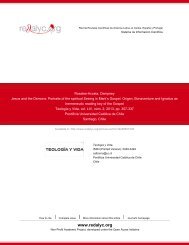A Key Concept in Modern Translation Theory - Redalyc
A Key Concept in Modern Translation Theory - Redalyc
A Key Concept in Modern Translation Theory - Redalyc
Create successful ePaper yourself
Turn your PDF publications into a flip-book with our unique Google optimized e-Paper software.
Equivalence Revisited:<br />
A <strong>Key</strong> <strong>Concept</strong> <strong>in</strong> <strong>Modern</strong><br />
<strong>Translation</strong> <strong>Theory</strong><br />
por<br />
SERGIO BOLAÑOS CUÉLLAR *<br />
Departamento de L<strong>in</strong>güística<br />
UNIVERSIDAD NACIONAL DE COLOMBIA<br />
This paper attempts to discuss the importance, relevance and validity of<br />
the concept of equivalence as a constitutive notion <strong>in</strong> translation theory.<br />
Equivalence is def<strong>in</strong>ed as a relation that holds between a Source Language (SL)<br />
text and a Target Language (TL) text. Our conception of equivalence is supported<br />
by a modern text-l<strong>in</strong>guistic theory that considers that the text is the unit of<br />
analysis of the communicative event and, as translation itself is seen as a<br />
communicative event, then logically, it should be studied from a modern textl<strong>in</strong>guistic<br />
approach. A brief background is provided to support this perspective.<br />
However, this is a po<strong>in</strong>t of view not necessarily shared by all modern translation<br />
theorists and, therefore, two antagonistic positions <strong>in</strong> translation theory as<br />
well as the criticism aga<strong>in</strong>st L<strong>in</strong>guistics/Text-oriented Theories (TOT) are<br />
analyzed. Then arguments for and aga<strong>in</strong>st the notion of equivalence with<strong>in</strong><br />
TOT and COT (Non-L<strong>in</strong>guistics/Context-oriented Theories) are discussed <strong>in</strong><br />
detail and new perspectives reviewed. F<strong>in</strong>ally, equivalence with<strong>in</strong> the framework<br />
of a Dynamic <strong>Translation</strong> Model (DTM) is discussed and a brief illustration<br />
of its application <strong>in</strong> translation criticism is provided.<br />
<strong>Key</strong> terms: <strong>Translation</strong> Equivalence, L<strong>in</strong>guistics/Text-oriented<br />
Theories (TOT), Non-L<strong>in</strong>guistics/Context-oriented Theories (COT),<br />
Dynamic <strong>Translation</strong> Model (DTM)<br />
1. BACKGROUND<br />
In memoriam<br />
Felipe Pardo<br />
About a decade ago (Bolaños 1990), we postulated the hypothesis that<br />
translation could be accounted for with<strong>in</strong> the field of l<strong>in</strong>guistics if a gradual<br />
approximation to expla<strong>in</strong><strong>in</strong>g its nature was used beg<strong>in</strong>n<strong>in</strong>g with the revision of<br />
the contribution Structural L<strong>in</strong>guistics and Generative Transformational Grammar<br />
*<br />
sbolanoc@yahoo.com<br />
FORMA Y FUNCIÓN 15 (2002), pág<strong>in</strong>as 60-88. © Departamento de L<strong>in</strong>güística, Universidad<br />
Nacional de Colombia, Bogotá, D.C.
















